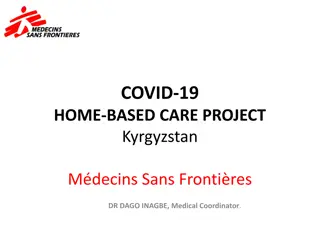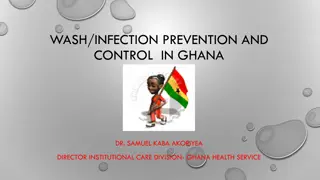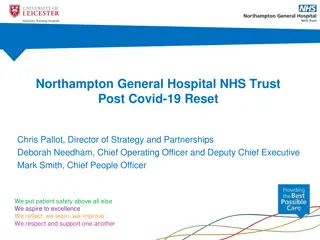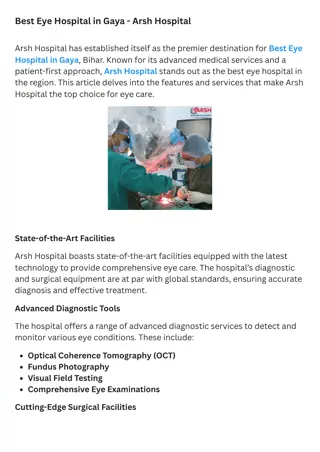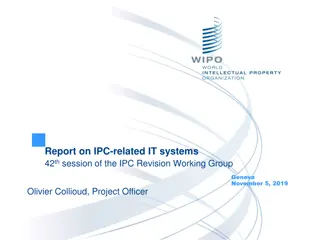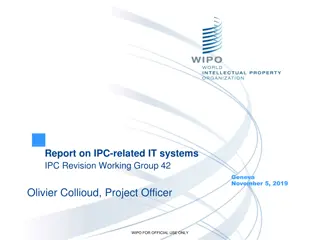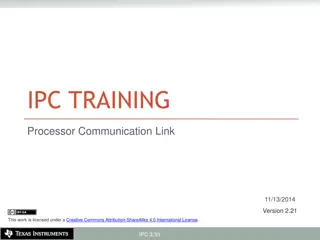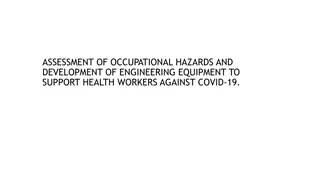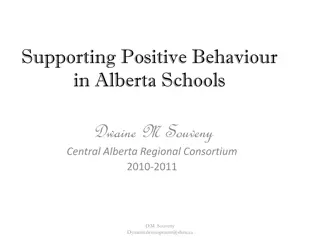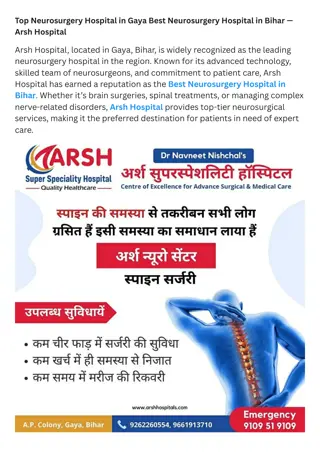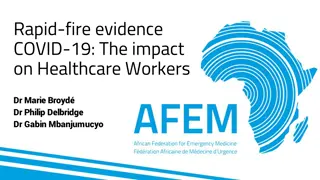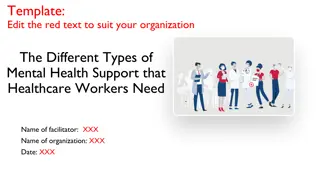IPC and Behavior Change Strategies for COVID-19 Positive Healthcare Workers at MC Hospital
This review discusses the implementation of infection prevention and control (IPC) measures and behavior change strategies for COVID-19 positive healthcare workers at MC Hospital. The presentation outlines the introduction of the hospital, COVID-19 positive staff statistics, IPC strategies, outcomes, and challenges faced during the response to initial cases. It includes information on the staff testing positive for COVID-19, recovery rates, and statistics based on job descriptions.
Download Presentation

Please find below an Image/Link to download the presentation.
The content on the website is provided AS IS for your information and personal use only. It may not be sold, licensed, or shared on other websites without obtaining consent from the author. Download presentation by click this link. If you encounter any issues during the download, it is possible that the publisher has removed the file from their server.
E N D
Presentation Transcript
Title: Title:Covid 19 positive healthcare workers, a review of IPC and Covid 19 positive healthcare workers, a review of IPC and behaviour change strategies implemented at MC hospital behaviour change strategies implemented at MC hospital Preventing and controlling transmission of COVID 19 infection Presenter: Sekai Lilian Rubayah- IPC practitioner, PDIC- Buse 1
PRESENTATION OUTLINE INTRODUCTION COVID 19 POSITIVE STAFF STATISTICS IPC BEHAVIOUR CHANGE STRATEGIES OUTCOMES CHALLENGES
INTRODUCTION MCH is a group of 4 Hospitals ie Paediatric Hospital, Maternity Hospital, General Hospital and Opportunistic Infections Hospital and caters for patients of all ages with medical, surgical, and gynaecological problems. It is a referral centre in the Southern Region of Africa for cancer patients, where Radiotherapy and chemotherapy is offered. It is a training school for General nurses and midwives. Staff establishment is 1744 Bed capacity 1000
HOSPITAL COVID 19 INFOMATION First institutional recorded cases 3 Date: 28 May 2020 Midwife working in LW A patient in a orthopedic ward A patient in a gynecological ward
RESPONSE TO INITIAL CASES Nurses who were contacts to the three positive case immediately went into quarantine at their homes Strengthening of IPC measures (admin, envir, ppe) Patients were discharged home RRT City started contact tracing and PCR testing those who tested positive and their home environments were not conducive for isolation were sent to a quarantine Centre.
STAFF COVID 19 POSITIVE-181 120 May-1 100 June-51 80 July-113 60 August-14 40 September-2 20 0 October-0
99.4% recoveries 1 death- Nurse with existing comorbidities
STATISTICS BY JOB DESCRIPTION Nurses- 41.4% Doctors- 3.8% General hands- 6% Students- 36.4% Pharmacy staff- 6.6% Laboratory- 0.5 % NURSES GENERAL HANDS PHARMACY DATA CLECKS SECURITY DOCTORS STUDENTS LABORATORY COUNCELLOR Clerks- 2.7% Counselors -1.6% Security- 0.5%
POSSIBLE CAUSES FOR THE RISE IN THE CASES Insufficient PPE Poor hand hygiene habits Long working hours Direct patient contact Asymptomatic transmission Reduced immunity
STRENGTHENING IPC INTERVENTIONS ADMNINISTRATIVE CONTROLS ENVIRONMENTAL CONTROLS PPE
ADMINISTRATIVE SUSPECTED SOURCE CONTROL TRAININGS of HCWs RISK ASSESSMENT -1 visiting time, 1 visitor -surveillance and reporting system -Risk communication Signage in public areas -Rapid triage -screening tents -Investigations -rapid diagnosis -isolation -patient placement -patient transfer (PUI)ward -Dedicated staff and equipment -provision of masks to patients -Standard precautions -Transmission based precautions -Case management -Waste management -Linen management -Equipment decontamination Environmental cleaning
ENVIRONMENTAL CONTROLS Transmission based precaution Environmental cleaning Waste management Contact & droplet precautions -patient placement ( social distancing) -natural ventilation -checklists Strengthened supervision of cleaners Strengthened waste management
PERSONAL PROTECTIVE EQUIPMENT Received a lot of donations and the hospital also procured PPE N95,surgical mask, gloves, face shields, coveralls, disposable Gowns and aprons ABHR Donning and doffing posters
IPC BEHAVIOR CHANCE IN COVID 19 Ipc behaviour change is of great significance which could help guide evidence based optimal IPC behaviours to combat future large scale outbreaks Despite the importance of IPC in covid 19, compliance to IPC guidelines before the diagnosis of the initial cases was suboptimal As more health workers got infected and trainings conducted, a significant difference in behaviour and adherence to protective and preventive measures was observed and it helped in protecting them from contamination and prevention of disease transmission as shown by the decline in the new cases over a period of 5 months.
BEHAVIOR CHANGE HCW from higher risk departments (entry points and PUI department) have better practice in most IPC behaviours. Worst IPC behavior were however noted in some areas with higher workload and insufficient supply of resources Also noted was that general preparedness in the different departments and years of experience of cadres in service influenced IPC behavior change
HAND HYGIENE COMPLIANCY- WHO OBSERVATION TOOL USED Hand hygiene practices overall satisfactory especially after body fluid exposure and before aseptic procedures. (69% compliance rate) Hand hygiene before touching a patient and after patients surroundings is still low which may hinder the prevention ant control of Covid 19. (54% compliance rate) Generally, availability of ABHR is satisfactory- hospital provides efficiently and a lot of donations are being received
PATIENT PLACEMENT Social distance markings in patient waiting areas and patient placement in the wards >1,5m can be observed and its every HCWs duty to ensure this primary measure to contain the epidemic
USE OF PPE Soon after the detection of the initial cases, HCWs demanded PPE due to panic like coveralls,N95, shields and were double gloving. After Covid trainings: Majority is complying to using PPE as in guidelines. Compliance of mask and glove use is high all round the hospital Use of PPE like goggles, face shields is still unsatisfactory as people complain with some materials which becomes foggy and reduce visual acuity or are just uncomfortable.
OUTCOMES OF BEHAVIOR CHANGE Strict strengthening of standardized preventive measures and strengthening protective measures Improved staff safety Reduced staff infection rates Reduced transmission of covid 19 within hospital and communities Reduced purchasing of PPE Increased nurse patient ration as nurses are not going for self isolation
IPC CHALLENGES PPE supplies still limited- can use 1 mask throughout 12 hour shift Wearing 2 products simultaneously esp gloves and mask by some cares ( esp not trained) No fit testing of N95, one size is supplied Delay in getting covid results
ACKNOWLEDGEMENTS Hospital executive, Ministry of Health and Child care, Nursing Directorate and NGOs who supported and funded all trainings Africa CDC IPC and ICAN
THE END THANK YOU




